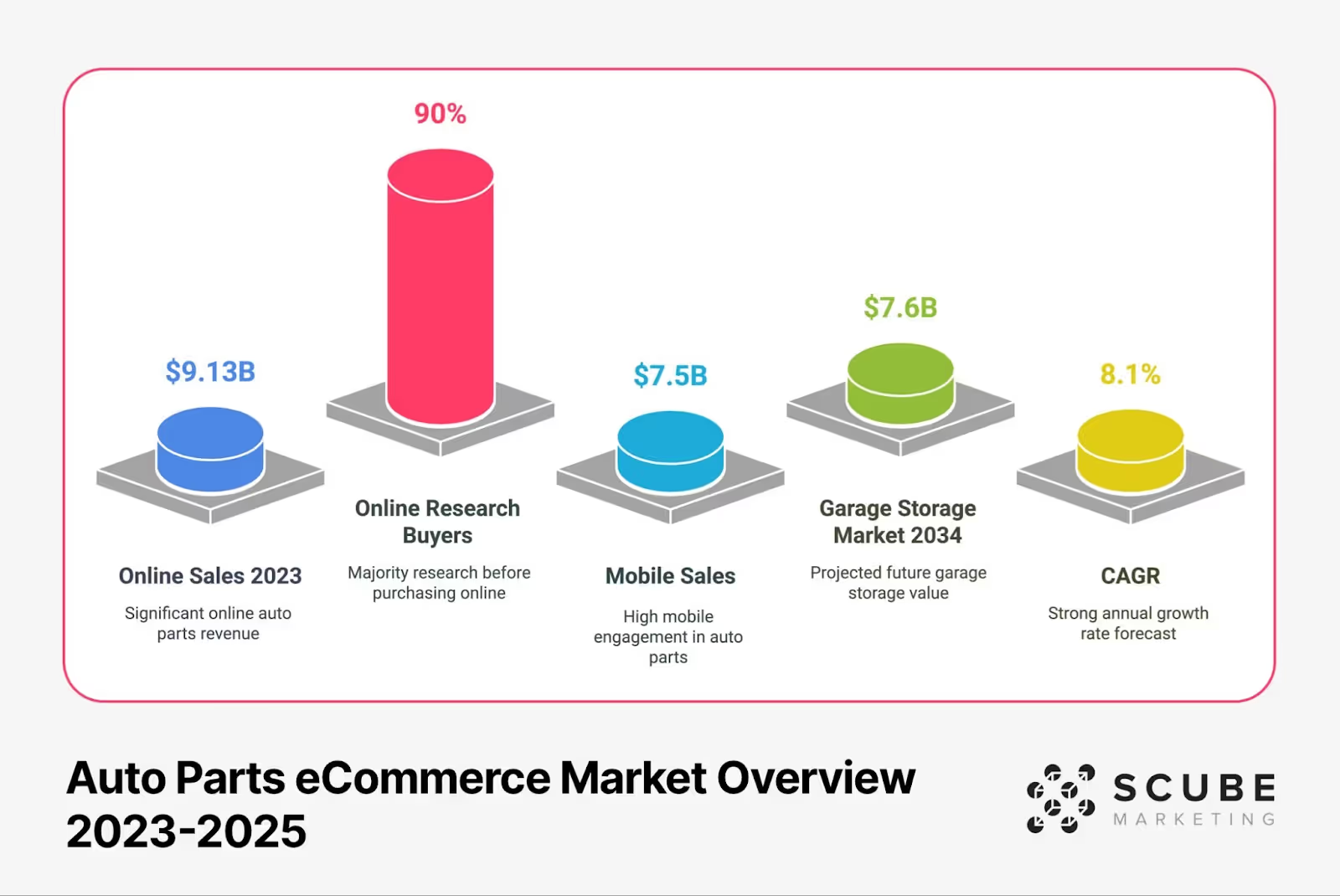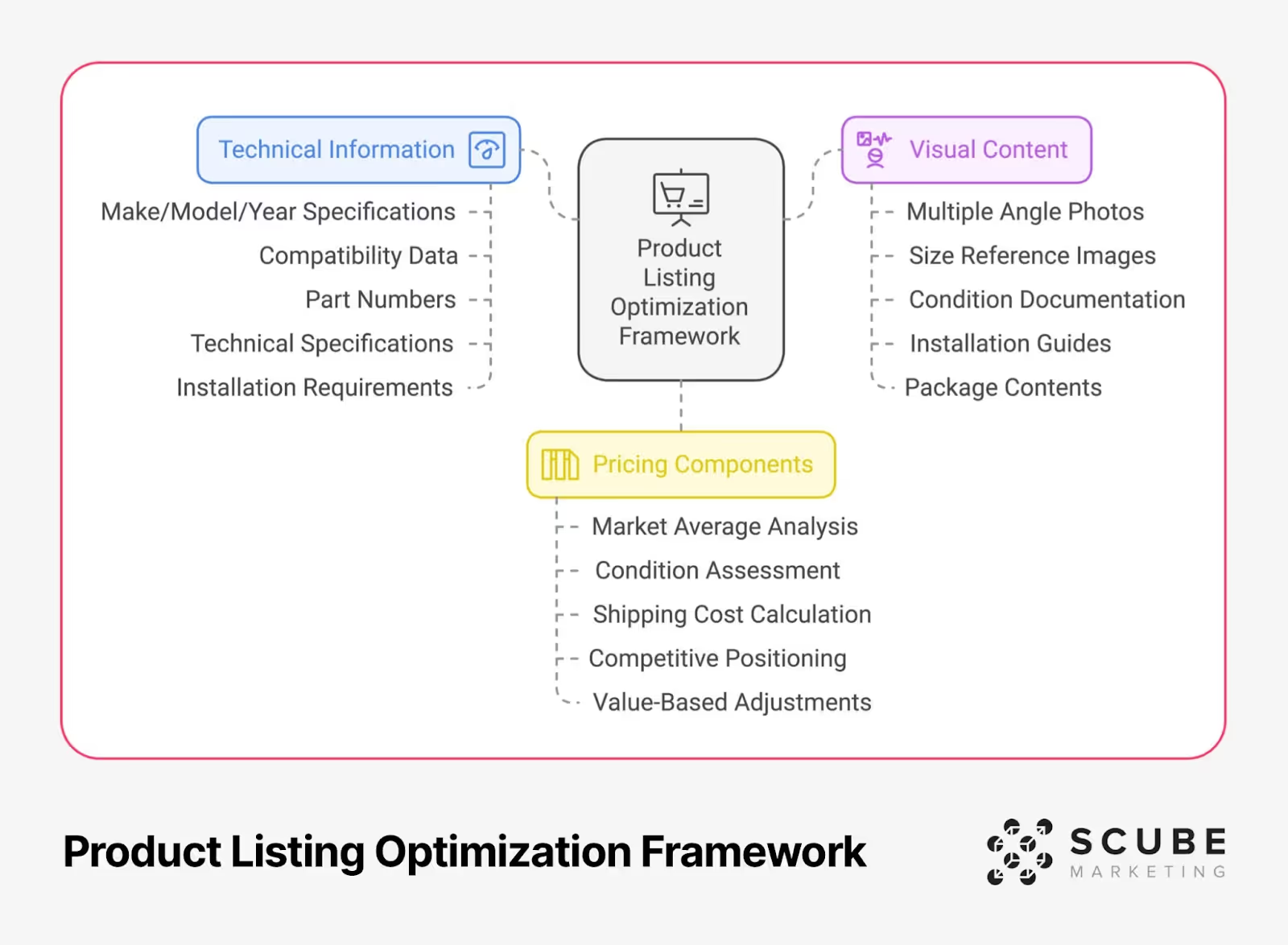
Auto parts sales have shifted into high gear online, with retailers generating $9.13 billion in sales during 2023 (Source: Digital Commerce 360). Whether you're a seasoned mechanic with excess inventory or an entrepreneur spotting an opportunity, transforming your garage into a profitable online auto parts business requires more than just listing products and hoping for sales.

Success demands a fine-tuned approach to both physical organization and digital presence - think of it as building a high-performance engine where every component needs to work in perfect harmony.
This guide will walk you through the essential steps to establish and grow your online auto parts business, from organizing your garage like a professional warehouse to selecting the right automotive marketplace platforms for maximum visibility.
The automotive aftermarket has undergone a dramatic transformation, with online sales accelerating faster than a quarter-mile dragster.
Nearly 90% of auto parts buyers now conduct online research before making a purchase (Source: Hedges Company). This shift in consumer behavior has created unprecedented opportunities for sellers who can effectively bridge the gap between physical inventory and digital commerce.
The surge in online auto parts sales isn't just a temporary trend - it's a fundamental shift in how customers shop for automotive components. Mobile sales alone generated $7.5 billion in revenue, highlighting the importance of a strong digital presence. For sellers looking to tap into this market, understanding both the physical and digital aspects of the business is crucial for mapping the customer journey effectively.
A well-organized storage system isn't just about keeping things tidy - it's the foundation of a profitable auto parts business. The North American garage storage market is projected to reach $7.6 billion by 2034 (Source: Garage Storage Solutions), and there's good reason for this growth. Just as a professional mechanic's toolbox has a place for every socket and wrench, your storage space needs to function like a precision instrument.
Think of your garage space like a 3D puzzle where every cubic foot counts. Start with these proven storage solutions:
The key to efficient storage isn't just about cramming more parts into your space - it's about creating a system where every item is easily accessible and trackable. This approach to inventory management directly impacts your ability to fulfill orders quickly and maintain accurate listings.
Implementing a robust categorization system is crucial for maintaining order and efficiency. Consider these organizational principles:
Remember that your physical organization system directly impacts your online operation's success. A well-organized storage space reduces picking time, minimizes errors, and ensures accurate inventory counts - all crucial factors for maintaining positive customer reviews and repeat business in the competitive online auto parts market.
Selecting the right digital marketplace is like choosing the perfect racing line - it can make the difference between leading the pack or getting lost in the crowd. Amazon's share of consumer spending on car parts reached 9.6% in 2023, up significantly from 7.1% pre-pandemic (Source: PYMNTS). Let's break down your main platform options and their unique advantages.
Each marketplace requires a tailored approach to maximize your success. Here's how to leverage each platform's unique features:
eBay's automotive marketplace thrives on detailed fitment data and comprehensive listings. Their Parts Compatibility tool has driven significant increases in conversion rates. Focus on:
Success on Amazon requires a strategic approach to inventory management and fulfillment. Consider:
Platforms like RockAuto and CarParts.com offer targeted exposure to serious auto parts buyers. These specialized marketplaces require:
Your choice of platforms should align with your inventory type, fulfillment capabilities, and business goals. Many successful sellers maintain presence across multiple platforms to maximize visibility and diversify their revenue streams. Think of it as not putting all your parts in one toolbox - spreading your inventory across strategic channels can help protect against market fluctuations and platform-specific challenges.
With automotive parts eCommerce projected to reach $41 billion in 2023 (Source: Hedges Company), establishing a strong online presence isn't optional - it's as essential as having the right tools in your toolbox. Let's dive into creating a digital storefront that converts browsers into buyers.
Your online store needs to run as smoothly as a well-tuned engine. Here's how to build a high-performance digital presence:
Think of your product listings as your digital showroom. Just as you'd want customers to see every detail of a part in person, your online listings should provide that same level of confidence through detailed descriptions and clear imagery.
Setting the right price point requires balancing market competitiveness with profitability. Consider implementing a value-based pricing strategy that accounts for:
Outstanding customer service can be your competitive edge in the crowded auto parts market. Focus on:
Implement a customer service system that handles inquiries efficiently. Think of it like a well-organized service department - every customer interaction should be handled professionally and promptly.
Your shipping strategy can make or break your online auto parts business. Consider these key elements:
Remember, your online presence extends beyond just listing parts - it's about creating a complete customer experience that builds trust and encourages repeat business. Just as a master mechanic's reputation is built on reliability and expertise, your online store should reflect the same level of professionalism and attention to detail.
With the auto parts online market growing at an impressive 8.1% CAGR (Source: PYMNTS), optimization isn't just about fine-tuning - it's about supercharging your business for maximum performance. Let's look at the key areas that need regular attention and adjustment.

Just as a high-performance engine needs the right fuel mixture, your business needs the right marketing blend to perform at its peak. Focus on these key areas:
Implement these SEO fundamentals for better visibility:
Build your brand through strategic social media engagement:
Monitor your business performance like you would track engine diagnostics. Focus on these key metrics:
Implement these essential analytics tools to track and improve performance:
Like maintaining a high-performance vehicle, your business needs regular tune-ups. Implement these optimization practices:
Success in the online auto parts market requires constant attention to detail and willingness to adapt. Use your performance data to drive decisions about inventory, pricing, and marketing strategies. Think of it as maintaining a championship racing team - every component needs to be operating at peak efficiency for optimal results.

As the garage organization market continues to grow at a 7.0% CAGR (Source: Strikingly), more entrepreneurs are entering the online auto parts market. Here are answers to the most common questions about starting and growing your business.
The initial investment varies based on your inventory strategy and storage setup. Focus first on essential storage solutions and a small, curated inventory of high-demand parts. Start with proper shelving, inventory management tools, and packaging supplies. Expand your inventory as you learn what sells best in your market.
eBay Motors often provides the easiest entry point for new sellers, offering 250 free listings monthly and built-in vehicle compatibility tools. The platform's auction format also helps you understand market pricing while building your customer base.
Consider using inventory management software that integrates with multiple marketplaces. This helps prevent overselling and maintains accurate stock levels across all platforms. Think of it as having a master computer for your diagnostic tools - one central system managing multiple outputs.
Develop clear, written policies for returns and maintain professional communication throughout the process. Document all part conditions before shipping and require photos of any claimed damages. Handle issues promptly to maintain positive feedback ratings.
Focus on these competitive advantages:
Consider a hybrid approach. While marketplaces provide immediate access to customers, your own website through platforms like Shopify offers better control over branding and customer relationships. Many successful sellers maintain both marketplace presence and their own ecommerce site.
Remember these key points as you build your online auto parts business:
Your success in the online auto parts market depends on treating it like a professional automotive operation - with attention to detail, technical accuracy, and customer satisfaction as your top priorities. Keep learning, stay organized, and maintain high standards in every aspect of your business.
Ready to start your online auto parts business? Begin with organizing your storage space and researching your target market. Remember, like building a custom car, creating a successful online business takes time, patience, and dedication to quality. For more guidance on growing your automotive business online, explore our automotive marketing resources.